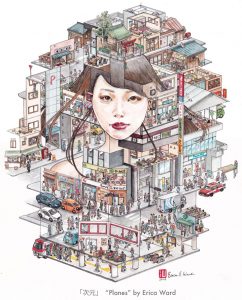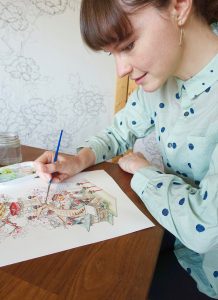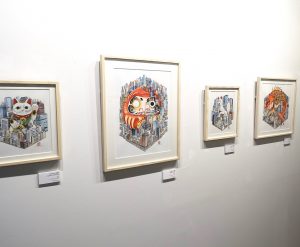Interview with Tokyo Illustrator, Erica Ward
This article originally featured in the September 2020 issue of Connect.
Jessica Craven (Saitama)
Erica Ward is one of the most active foreign artists I have seen in the Tokyo metro. I first saw her work at her solo exhibition Rosenzu-iro at CLOUDS ART + COFFEE gallery in Koenji, and I have been dying to ask her more about her illustrations ever since. I think she is very inspiring to other foreign artists in Japan, so I am thrilled to share our interview with you!

J: Where are you from, how long have you been in Japan, and what made you decide to come here?
E: I’m from Santa Cruz, California, and have been living in Japan since 2010.
I studied Japanese in both high school and university, and Japan was always a place and culture that held a lot of interest for me.
When I was a teenager, I had a very special chance to do a two-week host family stay in Santa Cruz’s sister city, Shingu, Wakayama. That visit really cemented my feeling that Japan was somewhere I wanted to spend more time. Sometimes I think about how those two weeks really influenced the course of my life.
I’ve always loved to draw, and Japanese culture and art also inspired creativity in me. Part of wanting to move here was a desire to be closer to that creative energy.
J: Tell us about your work.
E: I create pen and watercolor artworks that often include Japanese imagery and slight surrealism. I like to use watercolor to render people and objects semi-realistically, but then I use stark pen outlines to give the images a flat and more graphic look. Many of my pieces are bijin-ga, portraits of women in kimono, yet often with elements that break them out of the typical bijin-ga category.
J: What kind of themes or ideas does your work explore?
E: I like to present familiar things in a way that is not familiar.
By putting everyday objects or scenes into a new context, I think it puts a spotlight on those things as something special that we should appreciate or give some extra thought to. Similarly, I like to put a slight spin on established symbols, such as Japanese seasonal imagery.
Lately, I’m also interested in expressing the relationship of identity—specifically, how the identity of the individual and the identity of the city are both completely independent and yet entirely interwoven at the same time. By drawing figures literally woven into city scenes, I’m searching for a wordless way to express this dynamic visually.

J: Where do you look for inspiration?
E: Often, I find inspiration in common scenes or objects when I least expect it. For example, in street signs, subway stations, old buildings. Something will catch my eye and, somewhere in my imagination, ideas start flashing around until suddenly, one day, I know that I have to sit down and turn the idea into a painting.
The last few years living in Tokyo, I’ve been in continual amazement of how intricate the structure of the city is―the endless buildings and the overlapping layers of subways, basements, trains, busses, skyscrapers … My artwork has grown more detailed and architectural since moving here, and inspiration is very connected to where I am physically.
J: Do you have a “formal” art education, or how did you learn how to illustrate?
E: I did not attend art school. I actually majored in Japanese and Linguistics at the University of Massachusetts, so, since childhood, I thought of art as a hobby rather than a strict career path. I was always doodling and sketching and, over time, had built up a small body of work. I did not receive any training or formal instruction, but my style likely evolved into something different than it would have been had I had a formal art education.
J: How did you get your start exhibiting work in Japan?
E: When I lived in Iwate, I made a lot of good friends, and they had started to notice some of my artwork that I’d posted on my social media pages. One friend reached out to ask if I would try hosting an art event with her, and we rented a space and did everything very DIY. We were blown away with the positive response of our friends, respective coworkers, and community, who came to see our show. This was the first event at which I presented myself as an artist, and I think it really opened up my confidence.
Later that year, I was put in touch with an artist in the town who had put a lot of love and effort into converting an old country school into a community art museum and art center. I remember being nervous handing her my portfolio and watching her look over my pieces. Closing the book, she said, “Let’s do an exhibition. Now get home, you have your work to do!” It was the first time anyone would have called drawing my “work,” so I was very encouraged and motivated by her words.
Since then I have felt confident to approach venues or apply to events or exhibitions, and also can never downplay the support and connections that come from the community wherever I’ve lived—and also, a touch of serendipity.

J: How do you think being in Japan has influenced or changed your art or yourself?
E: Living in Japan has definitely changed my art, and surely myself as well. What first comes to mind is a memory of myself some years ago, living in the countryside, saying, “I could never live in Tokyo,” imagining the streets busy and everything constantly noisy and crowded. Now I love Tokyo—and it’s not at all how I had assumed. I suppose just living in a foreign country and realizing how adaptable we really can be has changed me.
And my art, absolutely, as I have gained more understanding of cultural topics and images to
depict and career opportunities with art as well. Last year, I illustrated a calendar for a Kyoto-based printing company, and it gave me a chance to really dive into researching Kyoto’s traditions and a chance to paint subject matter I love. This kind of chance wouldn’t have arisen if I lived outside of Japan, and my art continues to evolve with each experience.

J: Could you tell us about one (or more) of your recent exhibitions in Japan?
E: Last summer, I exhibited a series titled Rosenzu-iro (Colors of the Train Lines). This
was a bijin-ga series of female portraits that
paired a face to each color of the Tokyo
subway lines. I positioned objects that share the subway line color around each face and titled each piece after their respective line. For people living in Tokyo, the subway colors are something we see every day and feel a kind of endearing relationship with. We have such a fond connection with the colors but only ever get one context within which to see them. I wanted to play with the emotional connection we have to these colors by giving them a fresh new context.
My most recent exhibition, Engimono, was held at CLOUDS ART + COFFEE gallery in Koenji. This time, I broke away from figurative work and instead focused on engimono (Japanese lucky items) and cityscapes—weaving a giant Daruma, manekineko, and others into detailed cityscapes. Unlike my former works, this series had no people depicted on the tiny streets, an influence of seeing how the city changed during the state of emergency for coronavirus. I wanted the engimono to hopefully attract positive energy back into the year and also highlight the city and our neighborhoods as something that gives us security and something we should appreciate.
J: Do you have any other exhibitions scheduled currently?
E: No exhibitions scheduled as we all wait and watch with coronavirus. I do tabling events such as Design Festa, which is scheduled for November 7th and 8th, but there is a large chance it will be postponed. I plan to hold another solo exhibition in Koenji in summer 2021 and post any updates about exhibitions and events on my website.
J: What advice do you have for any foreign artists seeking to make connections or exhibit work in Japan?
E: I would say explore a variety of communities and get involved. Seek out art events and exhibitions by other artists, and show your support for people doing the kind of thing that you would like to try. In Tokyo, especially, there are endless events, group exhibitions, and so on; so, a little research, confidence, and sincerity can go a long way.
If you live in a more rural area, get to know business owners who might be interested in displaying art at their shop or suggest co-hosting an event. Local community centers have space available to reserve. People will be excited to support you but need to know what you are working on first!

If you would like to see more of Erica’s work, check out the following sources:
- Website: ericawardart.com which links to my webstore (English/International and Japanese/Domestic)
- IG: https://www.instagram.com/erica.ward.illustration/
- Facebook: https://www.facebook.com/ericawardart/
- Illustration books of both the Rosenzuiro series and Engimono series mentioned above are available for purchase for anyone interested in checking out the full series.
Jessica is a fourth-year American JET living in Saitama. On weekends she enjoys hiking in remote areas of Saitama or taking day-trips to Tokyo. When not adventuring, she can be found reading or creating her own artwork, which can be seen on her Instagram @jessica_craven_art.



![CONNECT ART ISSUE 2024 SUBMISSIONS [CLOSED]](http://connect.ajet.net/wp-content/uploads/2024/04/ARTISSUE-INSTA-600x500.png)





